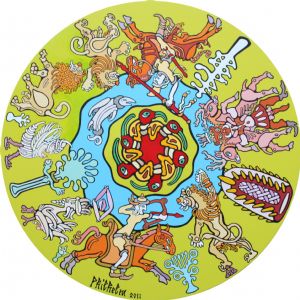| |

|

|
B155 - Antique Achaemenid hunting - 2011.
Painting Oil
Size: B155 - Antique Achaemenid hunting - 2011.
5700 USD
Description:
B155 - Antique Achaemenid hunting - 2011. Oil on canvas - 95 cm diameter circular 37,4 inches - frame moving with a ball bearing on the central axis
A few words about the Achaemenid civilization to locate the subject in time: The Achaemenid Empire (Old Persian Haxâmanishiya) (c. 550-330 B.C.), known as the first Persian Empire, expanding to eventually rule over significant portions of the ancient world which at around 500 B.C. stretched from the Indus Valley in the east, to Thrace and Macedon on the northeastern border of Greece. The Achaemenid Empire would eventually control Egypt, encompassing some 1,000,000 square miles (2,600,000 km2) unified by a complex network of roads and, ruled by monarchs, to become the greatest empire the world had yet seen. Calling themselves the Parsa after their original territorial range Parsua, Persians had settled in the southwest Iranian plateau, bounded on the west by the Tigris River and on the south by the Persian Gulf which had become their heartland for the duration of the Achaemenid Empire. It was from this region that eventually Cyrus the Great (Cyrus II of Persia) would advance to defeat the Median, the Lydian, and the Babylonian Empires, opening the way for subsequent conquests into Egypt and Asia minor. At the height of its power after the conquest of Egypt, the empire encompassed approximately 8 million km2 spanning three continents: Asia, Africa and Europe. At its greatest extent, the empire included the modern territories of Iran, Pakistan, parts of Central Asia, Asia Minor, Thrace and Macedonia, much of the Black Sea coastal regions, Afghanistan, Iraq, northern Saudi Arabia, Jordan, Israel, Lebanon, Syria, and all significant population centers of ancient Egypt as far west as Libya. It is noted in western history, as the antagonist foe of the Greek city states during the Greco-Persian Wars, for emancipation of slaves including the Jewish people from their Babylonian captivity, and for instituting infrastructures such as a postal system, road systems, and the usage of an official language throughout its territories. The empire had a centralized, bureaucratic administration under the Emperor and a large professional army and civil services, inspiring similar developments in later empires. Contrary to popular belief, the vast size of the Persian Empire, and its extraordinary ethnocultural diversity across its realm, would not prove to be its undoing. The traditional argument is that the delegation of power to local governments eventually weakened the king's central authority, causing much energy and resources to be wasted in attempts to subdue local rebellions and this was the reason why when Alexander the Great (Alexander III of Macedon) invaded Persia in 334 B.C. he was faced by a disunified realm under a weak monarch, ripe for destruction. Examination of the evidence demonstrate that Achaemenid Empire was not facing any such crisis by the time of Alexander, and only internal succession struggles within the Achaemenid family ever came close to weakening the Empire. Alexander, an avid admirer of Cyrus the Great, would eventually cause the collapse of the empire and its disintegration around 330 B.C. into what later became the Ptolemaic Kingdom and Seleucid Empire, in addition to other minor territories which gained independence at that time. The Iranian Culture of the central plateau, however, continued to thrive and eventually reclaimed power by 2nd century B.C.
We come to the theme of the painting: The royal hunt, it is surely the favorite hobby of kings and princes. It has indeed the advantage of being a good physical preparation for the young noble, and an event in which he can show his courage, his skill and power (the first line is reserved). Hunting is practiced in "pairidaeza", parks closed wide area: in fact, the word for "having a fence on all sides." These gardens are both places of recreation and leisure, developed by horticulturists, and vast game reserves. Hunting techniques are varied: on foot, on horseback, by chariot, using the sword, the bow, the javelin, or the net. The fight of the lion with the man: Such a presentation of conflict is consistent with the image of the lion as the most powerful animal, and its dominance means the transfer of its strength to man. Note, however, that among the Assyrians, for example, the palaces are decorated with hunting scenes cruel; in Achaemenid, we often find peaceful processions of people dependent or majestic lions without apparent expression of ferocity, like the city of Suse.
Let's check the iconographic details: His presentation without high or low standard, and its kinetic rotational gives it a certain symbolism that I let you analyze if need be!. Another feature, in contrast Achaemenid elements around the canvas, the central birds are Assyrian faithful to their original representation. For those who want to know more about the different components present in the table, and this, in the opposite direction of clockwise, starting at the bottom near the signature, we have a Neo-Elamite rider shooting an arrow A Tree of Life, a lion fighting, a new Tree of Life, a monster deified, seen as a stranger among the Egyptian God, because from Arabia, it is "Bes", sometimes represented lifting and strangling two red deer, to get their wood for an apotropaic reason, function still used today by some shamans to deflect danger and protect their sponsors. (Dixit Leon Heuzey, archaeologist 1879). Follows a new Tree of Life, you will notice the wide variety of them! Comes a new Neo-Elamite rider with a spear against a lion fighting, followed by a second more peaceful. Then we find a single plant with its root, but more often represented at arm's reach of the Mesopotamian goddess of vegetation. Then a female anthropomorphic scorpion, one last Tree of Life, another anthropomorphic male bird royal appearance. Recall that in Mesopotamia, when we find two characters in front of a Tree of Life is to signify their desire to achieve or acquire immortality. To complete the loop, we find a lotus bud which differs from the Egyptian symbol always presenting the flower or the whole plant. Leave the edge to move towards the center across a marine space with a sacred symbol in a diamond shape, especially in the recurring glyptic of the time, but whose meaning was never really solved, sometimes referred to as the eye God sees everything. A fish, which as you know is for the Mesopotamian origin of humanity. The heart of the table ends up with six Assyrian birds.
Assyria: Assyria is an ancient region of northern Mesopotamia, which gets its name from the city of Assur.
Neo-Elamite comes from the Elam province Persian 1100 - 539 BC)
Anthropomorphic scorpion: the protector and defender of the way to the sun for it to do its long journey until sunrise. His head touches the ground of heaven! (But you already know thanks to my table B110!)
|
|

|
|